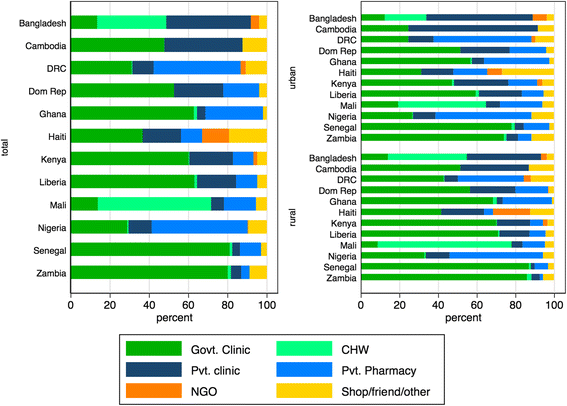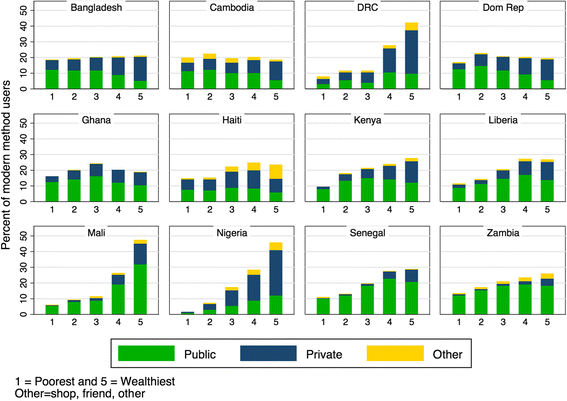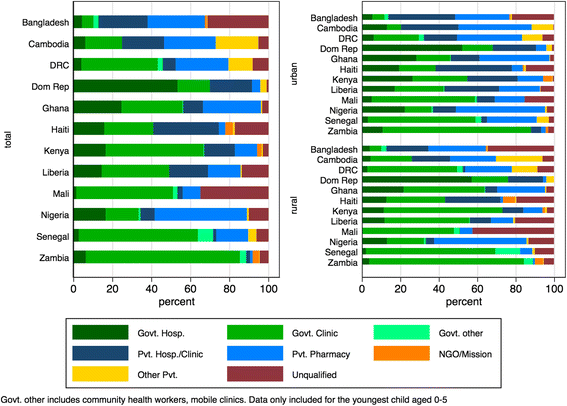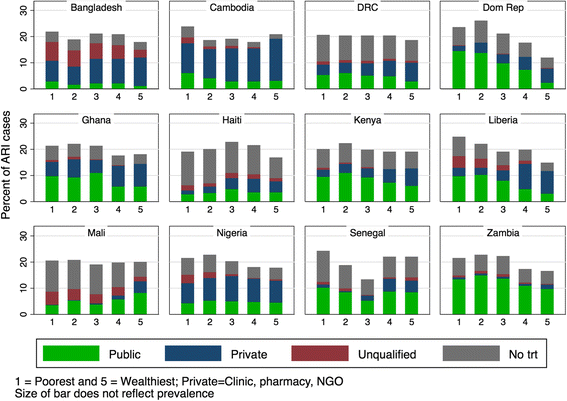Use of family planning and child health services in the private sector: an equity analysis of 12 DHS surveys
- PMID: 29690902
- PMCID: PMC5916835
- DOI: 10.1186/s12939-018-0763-7
Use of family planning and child health services in the private sector: an equity analysis of 12 DHS surveys
Abstract
Background: A key component of universal health coverage is the ability to access quality healthcare without financial hardship. Poorer individuals are less likely to receive care than wealthier individuals, leading to important differences in health outcomes, and a needed focus on equity. To improve access to healthcare while minimizing financial hardships or inequitable service delivery we need to understand where individuals of different wealth seek care. To ensure progress toward SDG 3, we need to specifically understand where individuals seek reproductive, maternal, and child health services.
Methods: We analyzed Demographic and Health Survey data from Bangladesh, Cambodia, DRC, Dominican Republic, Ghana, Haiti, Kenya, Liberia, Mali, Nigeria, Senegal and Zambia. We conducted weighted descriptive analyses on current users of modern FP and the youngest household child under age 5 to understand and compare country-specific care seeking patterns in use of public or private facilities based on urban/rural residence and wealth quintile.
Results: Modern contraceptive prevalence rate ranged from 8.1% to 52.6% across countries, generally rising with increasing wealth within countries. For relatively wealthy women in all countries except Ghana, Liberia, Mali, Senegal and Zambia, the private sector was the dominant source. Source of FP and type of method sought across facilities types differed widely across countries. Across all countries women were more likely to use the public sector for permanent and long-acting reversible contraceptive methods. Wealthier women demonstrated greater use of the private sector for FP services than poorer women. Overall prevalence rates for diarrhea and fever/ARI were similar, and generally not associated with wealth. The majority of sick children in Haiti did not seek treatment for either diarrhea or fever/ARI, while over 40% of children with cough or fever did not seek treatment in DRC, Haiti, Mali, and Senegal. Of all children who sought care for diarrhea, more than half visited the public sector and just over 30% visited the private sector; differences are more pronounced in the lower wealth quintiles.
Conclusions: Use of the private sector varies widely by reason for visit, country and wealth status. Given these differences, country-specific examination of the role of the private sector furthers our understanding of its utility in expanding access to services across wealth quintiles and providing equitable care.
Keywords: Childhood illness; Family planning; Private sector; Wealth.
Conflict of interest statement
Ethics approval and consent to participate
Not applicable.
Competing interests
The authors declare that they have no competing interests.
Publisher’s Note
Springer Nature remains neutral with regard to jurisdictional claims in published maps and institutional affiliations.
Figures






References
-
- Barros AJ, Ronsmans C, Axelson H, Loaiza E, Bertoldi AD, França GV, Bryce J, Boerma JT, Victora CG. Equity in maternal, newborn, and child health interventions in countdown to 2015: a retrospective review of survey data from 54 countries. Lancet. 2012;379:1225–1233. doi: 10.1016/S0140-6736(12)60113-5. - DOI - PubMed
-
- Mokdad AH, Colson KE, Zúñiga-Brenes P, Ríos-Zertuche D, Palmisano EB, Alfaro-Porras E, Anderson BW, Borgo M, Desai S, Gagnier MC, Gillespie CW, Giron SL, Haakenstad A, Romero SL, Mateus J, McKay A, Mokdad AA, Murphy T, Naghavi P, Nelson J, Orozco M, Ranganathan D, Salvatierra B, Schaefer A, Usmanova G, Varela A, Wilson S, Wulf S, Hernandez B, Lozano R, et al. Salud Mesoamérica 2015 initiative: design, implementation, and baseline findings. Population Health Metrics 2015 13:1. 2015;13:3. - PMC - PubMed
-
- World Health Organization . World health statistics 2016. Geneva: WHO; 2016.
-
- Montagu D, Anglemyer A, Tiwari M, Drasser K, Rutherford G, Horvath T, Kennedy G, Bero L, Shah N, Kinlaw H. Private versus public strategies for health service provision for improving health outcomes in resource-limited settings. 2011. pp. 1–80.
Publication types
MeSH terms
Substances
Grants and funding
LinkOut - more resources
Full Text Sources
Other Literature Sources
Medical

